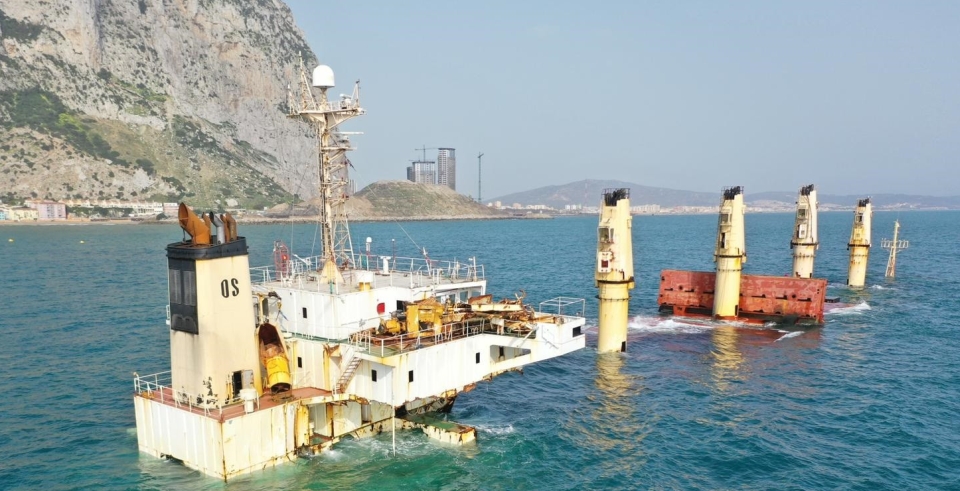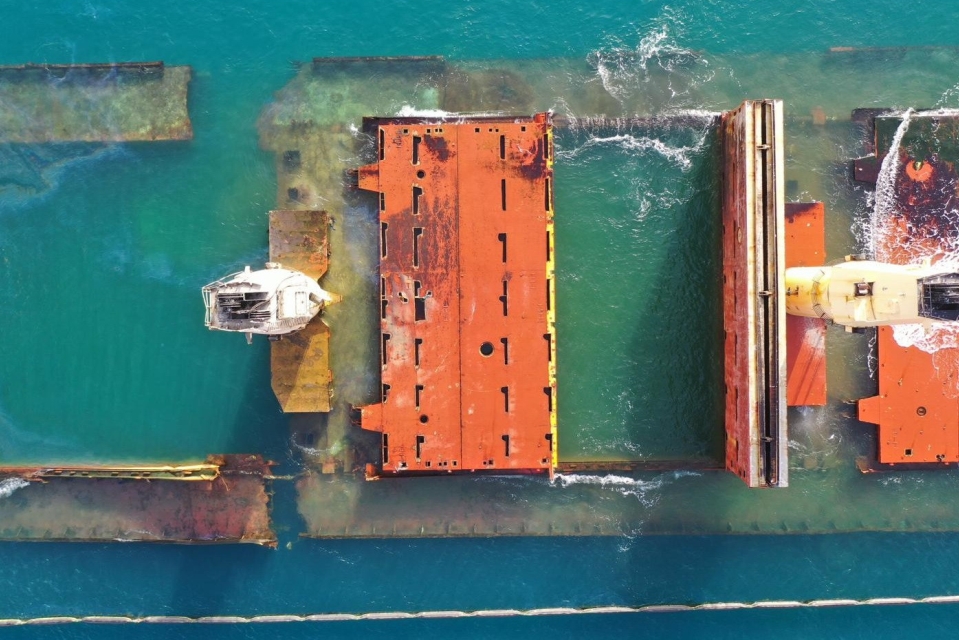According to the Gibraltar Port Authority, the partially submerged wreck of the bulk carrier OS 35 has suffered more damage as a result of recent storms. The two parts of the ship are now only tenuously held together by the bilge keel.
On 29 August, 2022, the OS 35 collided with LNG tanker Adam LNG in the Port of Gibraltar. Although the tanker only suffered minor damage, the bulk carrier suffered a ten by four-metre gash in the starboard side of the hull and was making water. It was directed to a location off Catalan Bay to beach and the bow went underwater.
Two days later, the hull broke, but the two parts did not fully separate. The vessel is sitting 700 metres off the shoreline of Catalan Bay. Since then, salvors have been busy removing fuel oil and diesel oil from the vessel as well as as much of the rest of the inventory and cargo as possible. The accident has resulted in several oil spills, with some oil reaching the shorelines. Booms and a catamaran that can skim the ocean surface have been deployed to catch as much of the oil as possible.
With upcoming bad weather, in September, it was decided to lower the aft of the OS 35 as well to allow the bulk carrier to better withstand waves.
Also read: Hull of partially sunk bulk carrier OS 35 in Gibraltar breaks
Damage to hull and accommodation
Damage to both the accommodation block and hull had been anticipated and prepared for with the stripping of the interior and unloading of the vessel prior to the onset of the bad weather. Whilst the wreck has sustained structural damage, most visibly to the starboard side of the accommodation block and hull, this is not considered to be extensive given the overall situation. The debris from this is contained within the site of the wreck.
The original crack in the hull has extended to the port side, which has caused the two parts of the hull to come further apart. The bow is now sitting a further 4 metres into the sandy sea bed, whilst the stern is now sitting a further 2 metres into the sea bed. This is a result of shifting sands with heavy swells.
However, the OS 35 has not moved from its original site. According to the Port Authority, this demonstrates the effectiveness of the strategy to stabilise the vessel with a controlled sinking. This provided the wreck with the maximum possible stability to weather the expected winter storms.

Inspection of fuel tanks
The damage to the hull has enabled divers to conduct visual inspections of fuel tank 1. As a result divers have been able to confirm that all four tanks that make up “Tank 1” have suffered damage. There is still some light sheening, which is being contained successfully within the boom.
The other set of fuel tanks, No 2 Fuel Tanks, remain undamaged and are situated in the aft area of the wreck, which has not suffered any damage. The dive survey has confirmed with certainty that these tanks are intact and are not at risk of failing and causing a sudden release of residues.
These tanks had been emptied in earlier stages of the operation and although it is likely that some residues remain and future light sheening can never be entirely ruled out, the risk of future escapes of oil is now dramatically reduced.
Also read: Cause of sheening of OS 35 located and removed
Wreck removal plans
The removal of the vessel’s cargo continues to be the first priority at this stage of the operation, with over 11,000 tonnes (representing around 1/3 of the total cargo) already removed. Between 600 and 900 tonnes of cargo are being removed daily. The damage caused by the storms has had no detrimental impact on the cargo removal operations or their timelines.
The current condition of the wreck and the damage to its hull and structure means that some of the plans for its final removal may need to be tweaked, although it is unclear as to how this may affect the projected timelines, if at all. The wreck is to be removed by the end of May this year.
Also read: OS 35 wreck to be removed before 30 May 2023
Environmental impact
As previously reported, small amounts of residual oil were found on Eastern Beach, Catalan Bay and the rocks at Sandy Bay in the aftermath of the storms. These had been anticipated and quickly dealt with by the P&I Contractors, monitored by the Gibraltar Port Authority and Department for Environment.
Due to the stripping of the accommodation’s interior in anticipation of the storms, no secondary contamination or debris was detected.
‘The damage to the vessel’s hull and accommodation block, whilst not ideal, were anticipated and prepared for with the removal of as much oil as possible and the complete stripping of the accommodation,’ says Captain of the Port, John Ghio. ‘These measures, together with the decision to sink the wreck in a controlled manner and thereby secure it in place, gave the vessel the maximum possible stability to withstand the winter storms as far as possible. Overall, I’m pleased that works continue to progress well, with cargo removal remaining as the current priority.’
All pictures by the Gibraltar Port Authority.









